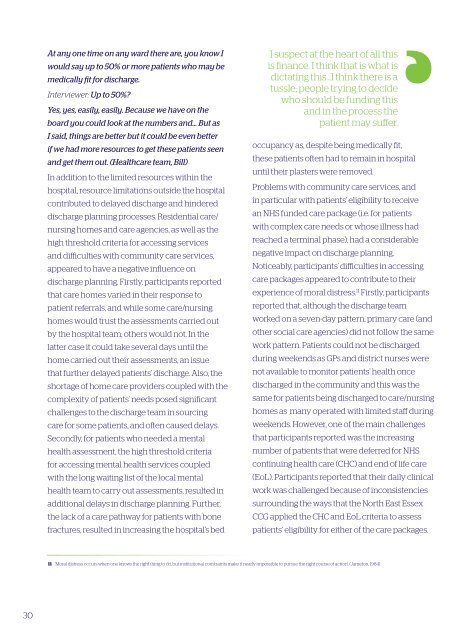Hospital Discharge
3Jzx309Yruj
3Jzx309Yruj
Create successful ePaper yourself
Turn your PDF publications into a flip-book with our unique Google optimized e-Paper software.
At any one time on any ward there are, you know I<br />
would say up to 50% or more patients who may be<br />
medically fit for discharge.<br />
Interviewer: Up to 50%?<br />
Yes, yes, easily, easily. Because we have on the<br />
board you could look at the numbers and… But as<br />
I said, things are better but it could be even better<br />
if we had more resources to get these patients seen<br />
and get them out. (Healthcare team, Bill)<br />
In addition to the limited resources within the<br />
hospital, resource limitations outside the hospital<br />
contributed to delayed discharge and hindered<br />
discharge planning processes. Residential care/<br />
nursing homes and care agencies, as well as the<br />
high threshold criteria for accessing services<br />
and difficulties with community care services,<br />
appeared to have a negative influence on<br />
discharge planning. Firstly, participants reported<br />
that care homes varied in their response to<br />
patient referrals, and while some care/nursing<br />
homes would trust the assessments carried out<br />
by the hospital team, others would not. In the<br />
latter case it could take several days until the<br />
home carried out their assessments, an issue<br />
that further delayed patients’ discharge. Also, the<br />
shortage of home care providers coupled with the<br />
complexity of patients’ needs posed significant<br />
challenges to the discharge team in sourcing<br />
care for some patients, and often caused delays.<br />
Secondly, for patients who needed a mental<br />
health assessment, the high threshold criteria<br />
for accessing mental health services coupled<br />
with the long waiting list of the local mental<br />
health team to carry out assessments, resulted in<br />
additional delays in discharge planning. Further,<br />
the lack of a care pathway for patients with bone<br />
fractures, resulted in increasing the hospital’s bed<br />
I suspect at the heart of all this<br />
is finance. I think that is what is<br />
dictating this…I think there is a<br />
tussle; people trying to decide<br />
who should be funding this<br />
and in the process the<br />
patient may suffer.<br />
occupancy as, despite being medically fit,<br />
these patients often had to remain in hospital<br />
until their plasters were removed.<br />
Problems with community care services, and<br />
in particular with patients’ eligibility to receive<br />
an NHS funded care package (i.e. for patients<br />
with complex care needs or whose illness had<br />
reached a terminal phase), had a considerable<br />
negative impact on discharge planning.<br />
Noticeably, participants’ difficulties in accessing<br />
care packages appeared to contribute to their<br />
experience of moral distress. 11 Firstly, participants<br />
reported that, although the discharge team<br />
worked on a seven-day pattern, primary care (and<br />
other social care agencies) did not follow the same<br />
work pattern. Patients could not be discharged<br />
during weekends as GPs and district nurses were<br />
not available to monitor patients’ health once<br />
discharged in the community and this was the<br />
same for patients being discharged to care/nursing<br />
homes as many operated with limited staff during<br />
weekends. However, one of the main challenges<br />
that participants reported was the increasing<br />
number of patients that were deferred for NHS<br />
continuing health care (CHC) and end of life care<br />
(EoL). Participants reported that their daily clinical<br />
work was challenged because of inconsistencies<br />
surrounding the ways that the North East Essex<br />
CCG applied the CHC and EoL criteria to assess<br />
patients’ eligibility for either of the care packages.<br />
11 ‘Moral distress occurs when one knows the right thing to do, but institutional constraints make it nearly impossible to pursue the right course of action’. (Jameton, 1984)<br />
30


